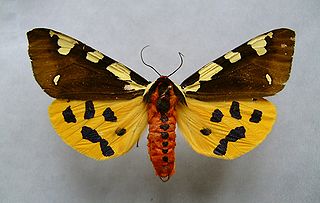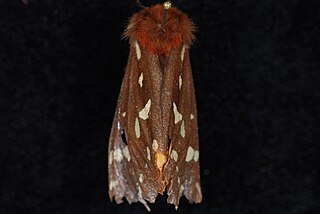
Arctia is a genus of tiger moths in the family Erebidae. Therein, it belongs to the subtribe Arctiina in the tribe Arctiini in the subfamily Arctiinae. Species are well distributed throughout North America, Palearctic, India, and Sri Lanka.

Arctia menetriesii, the Menetries' tiger moth, is a species of tiger moth in the family Erebidae. It was first described by Eduard Friedrich Eversmann in 1846. It is found in Karelia, Oktyabrskoe, northeastern Kazakhstan, Altai Mountains, Sayan Mountains, Evenkia, Yakutia, the central Amur region, Primorsky Krai and central Sakhalin. It was believed to be extinct in Fennoscandia, but the species has been recently recorded in Finland. This species is characterized by the fact that they never come to light; such behavior is atypical in the family Arctiidae.

Arctia villica, the cream-spot tiger, is a moth of the family Erebidae. The species was first described by Carl Linnaeus in his 1758 10th edition of Systema Naturae. It is distributed from the Iberian Peninsula across western and southern Europe, Anatolia, western and northern Iran, western Siberia, southwestern Asia and North Africa.

Arctia is species of tiger moth in the family Erebidae. It was first described by Carl Linnaeus in his 1758 10th edition of Systema Naturae. It can be found in central and eastern Europe, Kazakhstan, southern Siberia, northern Mongolia, Amur Region, Primorye, Sakhalin, Kunashir, northern and northeastern China, Korea and Japan.

Arctia virginalis, the Ranchman's tiger moth, is a species of tiger moth in the family Erebidae. It was first described by Jean Baptiste Boisduval in 1852.

Arctia tigrina is a moth of the family Erebidae. It is found on the Iberian Peninsula and the South of France and Italy.

Arctia aulica, the brown tiger moth, is a moth of the family Erebidae. The species was first described by Carl Linnaeus in his 1758 10th edition of Systema Naturae. It is found in the temperate areas of central Europe up to the area surrounding the Amur River to the east and up to the Balkans and the Black Sea to the south.
Arctia ladakensis is a moth of the family Erebidae. It was described by Otto Bang-Haas in 1927. It is found in Tibet and Xinjiang in China.
Arctia weigerti is a moth of the family Erebidae. It was described by Josef J. de Freina and Thomas Joseph Witt in 1985. It is found in northern Pakistan (Karakorum).
Arctia ornata is a moth in the family Erebidae. It was described by Otto Staudinger in 1896. It is found in the Russian Far East and Mongolia.
Arctia murzini is a moth in the family Erebidae. It was described by Vladimir Viktorovitch Dubatolov in 2005. It is found in Shaanxi, China.

Arctia parthenos, the St. Lawrence tiger moth, is a moth in the family Erebidae. It was described by Thaddeus William Harris in 1850. It is found in boreal North America, ranging from Alaska to Labrador, south to New Mexico and Arizona in the Rocky Mountains and to North Carolina in the Appalachian Mountains. The habitat consists of riparian areas and mixed hardwood-conifer forests at middle to high elevations.
Arctia allardi is a moth in the family Erebidae. It was described by Charles Oberthür in 1911. It is found in China.
Arctia buddenbrocki is a moth in the family Erebidae. It was described by Hans Kotzsch in 1929. It is found in Gansu and southern Shaanxi, both in China.
Arctia cupido is a moth in the family Erebidae. It was described by Yasunori Kishida in 1995. It is found in Nepal.
Arctia hannyngtoni is a moth in the family Erebidae. It was described by George Hampson in 1910. It is found in the north-western Himalayas and Nepal.
Arctia mirifica is a moth in the family Erebidae. It was described by Charles Oberthür in 1892. It is found in western China, Tibet and north-western India.
Arctia romanovi is a moth in the family Erebidae. It was described by Grigory Grum-Grshimailo in 1891. It is found in the north-western Chinese province of Qinghai.
Arctia forsteri is a moth in the family Erebidae. It was described by Franz Daniel in 1943. It is found in Sichuan, China.
Arctia kasnakovi is a moth in the family Erebidae. It was described by Vladimir Viktorovitch Dubatolov in 1987. It is found in Qinghai, China.








